My good friend, ecologist Jeff Parsons, broke trail through 16 inches of fine, fresh snow. The weather was clear, the temperature hovered in the single digits, and the January sun cast long, austere shadows across a pristine meadow that sloped gently toward the Missisquoi River. I followed about ten feet behind Jeff, staying in the deep trough his snowshoes made in the powder. Though we were still within view of my truck, I could already feel the sting of the icy air on my fingertips through my mittens. In my backpack, I carried two small, stillborn kids from my brother-in-law’s goat farm. Jeff carried four cameras, wire, wire cutters, lures, cables, and locks.
We were on a mission to camera-trap a bobcat.
If you’re going to photograph any kind of wildlife, knowledge of the animal is paramount. You cannot be a successful wildlife photographer if you’re not familiar with the habits and habitat of your subject. Indeed, the first rule of wildlife photography is go where there’s a lot of wildlife. Limited resources, like food and shelter, and seasonal events such as migration or reproduction, bring otherwise widely dispersed animals together, forming what’s referred to as clumped distribution. Some species, like bees at a hive, ant colonies, or prairie dogs have permanently clumped distributions. Other species, like birds at a roost, form frequent, albeit transient, clumps. Still other species, like bobcats, never congregate outside of the breeding season.
I’ve been photographing the landscapes and wildlife of the northeast as a professional nature photographer for over 20 years now, and I can hardly think of a species more challenging than the bobcat. Bobcats are wary of humans, and I’ve found that the mere handling of bait, footprints, or any human artifacts at the site can spook this animal. Though not impossible – I know a photographer who, after spending two winters sitting in his blind at subzero temperatures, got a few nice frames of a bobcat, as well as severe frostbite in his hands – it is improbable that one will get a good photograph of a bobcat in the wild. Hence, we decided to try using remote cameras.
Now considering the bobcat’s transient nature, and the fact that there are only about 3,000 of them in the entire state of Vermont (that’s not even a single bobcat per three square miles), you might conclude that we were on a fool’s errand. Yet, as dispersed as they are, bobcats have their favorite haunts, places where they are more likely to be found at any given time. As regular readers of Northern Woodlands know, cats use field edges and riparian zones – the banks of rivers and streams – as travel corridors. They’re also fond of ledges. This information tips the odds in favor of the camera hunter.
Jeff and I started scouting for this particular photo shoot earlier in the winter, when it was much easier to track animals. We looked for ledgy areas near rivers and then scouted the area for tracks and scent markings. When we discovered fresh bobcat tracks in the snow, we followed them. At times, the track swerved toward a scent-marking post – a tree trunk or some other object poking up out of the snow where the cat left its scent. If the tracks were ambiguous, we would breathe on the trunk to warm the urine and confirm the identification of the tracks by smelling the distinct, catlike odor of the marking. Because bobcats use scent marks to communicate with each other, strapping a camera to a marking post will, in time, yield a shot of a bobcat – though on second thought, you might want to strap the camera to a tree facing the scent mark.
For this particular shoot we opted to set up on a ledgy rim of rust-streaked yellow rocks about 300 yards beyond the Missisquoi River. Jeff and I had scouted out the serpentine ledges shortly after the first snowfalls in early December. To our delight, we found bobcat tracks, scat, and a number of scent markings all along the scree slope. We agreed on two places where we would establish our remote camera sites.
Now, a month later and in deeper snow, we found traversing the snow-covered scree slope to be a dodgy undertaking. There’s hardly any even footing, and it’s easy to plummet into a crevice between boulders hidden by a mantle of snow like a pit trap. We carefully angled our way over the scree to the base of the ledges, and before long arrived at one of our remote camera sites – a recess on the front of the cliff with a flat, rocky shelf that provides an ideal perch for a cat. It had a bit of an overhang, to which we could wire the goats. About six feet in front of the recess were two spruce trees where we could strap a couple of the cameras at slightly different angles. This arrangement would make it very likely that a cat would face a camera while it ate.
Jeff removed his snowshoes, clambered up onto the shelf, and began securing the bait, while I double checked the settings on the cameras, secured them to the tree trunks, and aimed them at Jeff ’s ankles, just about where we’d expect a bobcat to be when feeding on the carcasses.
Among the principal dos and don’ts of responsible nature photography is the requirement that the photographer not affect the behavior of the subject in any way. It might seem that using bait to attract an animal violates this rule, but bobcats are scavengers as well as hunters. Especially in winter, when some portion of their regular diet is lacking, bobcats will scavenge for whatever meat they can find, dead or alive. Nevertheless, ethics apply. It would be totally irresponsible to lure a cat, or any wild animal, off of its home ground, especially to a place that might put the animal in harm’s way. Place the bait along the animal’s usual route and keep it far afield of human activity, such that only you and the bobcat know where to find it.
In addition to ethical matters, there are other considerations in establishing a bait site. First, choose the appropriate bait. If you’ve ever lived with a cat, you know that they can be extremely fussy about their food. Bait that broadcasts a strong odor, even in cold weather, such as fish, will help your subject home in on your bait site and camera. If you do not have access to odorous bait, then augment the olfactory appeal of your bait with wildlife lures. Cats hate intruders, so smear some bobcat gland lure (available at any trapping supply company) on the trees around your bait site and the resident cat will come to investigate and defend its territory. If it’s below freezing, you might consider adding some propylene glycol to the lure, which will keep it from freezing. Never use tainted meat and only use bait when it’s cold enough to prevent meat from rotting before it’s consumed. Also, be sure to secure the bait. You want your subject to spend all of its time feasting in front of your camera. Don’t underestimate the strength of the animal – a bobcat can drag the carcass of a full-grown deer out of sight through deep snow.
I tend to ignore the conventional wisdom to keep the sun over my shoulder when I position game cameras. Instead, I find a shady but well-lit spot, something north-facing so that the camera isn’t triggered by the reflection of sunlight off trees, rocks, and snow. (Remember, these cameras are triggered by both movement and infrared radiation.) Keep branches, grasses, or anything that will move when the wind blows out of the composition to avoid hundreds of false exposures and thus drain the batteries prematurely.
I strive for a solid background in the composition, in the case of bobcats, typically a ledge. A fairly homogenous background about five feet behind where you expect to photograph your subject reduces clutter and prevents the background from going completely black whenever the camera fires its strobe. These cameras use wide-angle lenses so the nice separation one gets with a telephoto lens between a soft background and the sharp foreground isn’t possible. Position your camera and walk in front of it to get some test shots, with and without the flash. Depending on the quality of your camera, you may decide to leave the flash off and rely solely on daytime exposures, since our experience is that flashed images taken with these game cameras do not result in good exposures. Look for bright spots or distracting objects and make sure the camera is level and aimed properly. A few moments spent now to clean up the composition will save you heartache a week or two later when you discover that, though you have several dozen images of a beautiful bobcat, some consistent flaw in the composition means that no amount of Photoshop magic will save your images.
Finally, top off your odds of getting that keeper photo by using more than one camera. I know these units are a considerable investment, but so is your time, and if you’re sufficiently passionate about becoming a camera hunter, my advice to you would be to get at least two cameras. We usually position our cameras such that one faces the bait directly and another is off to the side, in order to capture a profile of the animal as it approaches. Jeff and I have just snowshoed three miles at 7oF, in deep snow, carrying 40 pounds of dead goat and gear on our backs over hazardous terrain. What’s more, we’ll be doing this repeatedly over the course of a New England winter. When that bobcat finally arrives at the bait site, we don’t want to rely on only one camera to get the shot.
Jeff and I tend to be meticulous and organized when we work in the field. We work quickly to reduce the disturbance we create at each site, but deliberately to be sure we haven’t overlooked anything. We broke off a couple of twigs from a spruce tree, dipped them into the bottle of wildlife lure, and wiped the twigs as high on the trunks and branches of nearby trees as we could reach in order to broadcast the scent far and wide. We had to remove our mittens to accomplish most of these tasks and our fingers were nearly frostbitten. The pain was excruciating. We broke out the disposable warm packs, shook them, and shoved them into our mittens. Finally, we consulted the checklist we made, including every detail, from mounting the bait in such a way that it does not appear in the composition to remembering to turn on the cameras. Satisfied that we’d not neglected any detail of the setup, we strapped on our snowshoes and headed down the scree slope, back to the river, and upstream about a mile to our second site.
Soon, the heat inside my mittens thawed my aching fingers. I reached into my jacket pocket for a couple of granola bars and handed one to Jeff. Along the way, we identified a number of tracks zig-zagging across the river – otter, turkey, deer, fisher, coyote, even a moose. Rounding a bend in the river, we caught a glimpse of an otter ducking into a hole in the ice while, off to the southwest, the bell at the Monastery of the Immaculate Heart of Mary in Westfield tolled noon.
When we returned to download the images two weeks later, among lots of snapshots of mice, raccoons, ravens, and a turkey vulture, we found this magazine-quality shot of a bobcat. I can’t wait to strap on snowshoes this winter and try to replicate the success, though I hope to skip the frostbite this time.


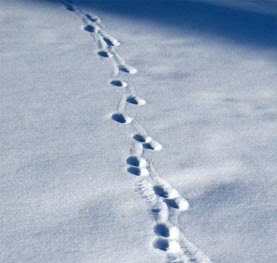
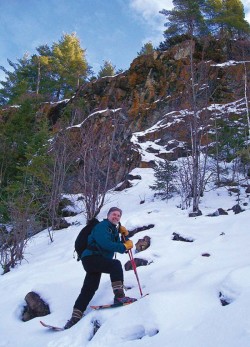
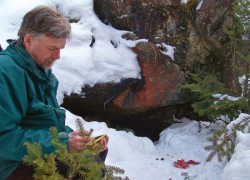
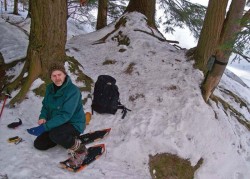
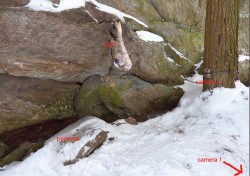
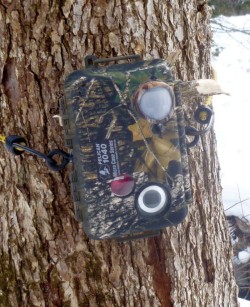
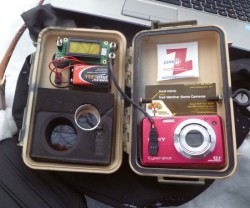
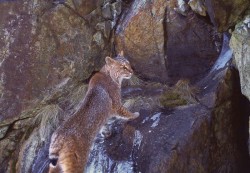
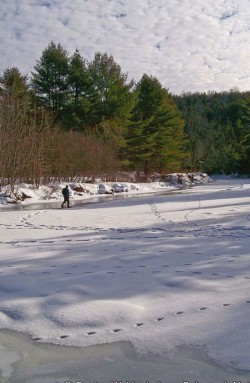
Discussion *